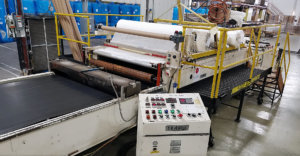Are You Considering High Pressure Laminate Manufacturers?

This is an option that business owners should consider. If you do need lamination services executed, is it necessary to handle all of them internally? The answer could be more complex than you might initially think. That’s why we’re delving into what is behind laminates, especially high pressure laminates, and how we deliver them.
What Is High Pressure Laminate?
If you are looking for a material that withstands high pressure conditions, it’s likely that you will encounter high pressure laminate at one point or another. But the question is, what exactly is high pressure laminate? Some have referred to it as a descendant of the original laminate, plastic laminate. Plastic laminate was a composite material, made up of resin, kraft paper, and various adhesives. While it was (and in some cases still is) relied upon by many, over time it became less preferred, in favor of high pressure laminate.
High pressure laminate, otherwise known as HPL, is a surface material. But it’s not just any surface material; in fact, many consider HPL to be one of the most durable surface materials on the market. It’s designed to stand up against chemicals, in addition to providing fire- and wear-resistance. There are other benefits to utilizing HPL as opposed to other forms of laminate. HPL can be applied to curved surfaces, like countertops for example. Other forms of laminate may not be as flexible. Additionally, they’re typically not as stable, and are more expensive than other forms of laminate.
How Is High Pressure Laminate Made?
So, how do you produce high pressure laminate? Typically, the high pressure laminate manufacturers involved will collect multiple layers of kraft paper. We saturate the paper with phenolic resin, and then we place printed décor paper on top for the sake of appearance. We put this concoction under heat and pressure; the pressure levels hit over 1,000 PSI. This process converts the resin into plastic and produces a rigid laminating sheet in the end.
Usually, the thickness levels of the HPL will be anywhere from .2 millimeters to .4 millimeters. The great thing about working with a contractor or toll manufacturer like Conversion Technologies International is that we manipulate the thickness of HPL to your specific preferences. Additionally, we apply HPL in the form of custom laminations, made to fit the project that you need executed exactly. It’s important to remember that though you may need high pressure laminate, you don’t necessarily need to make it in-house. Instead, you could potentially turn to third-party high pressure laminate manufacturers.
Why Work with Contract High Pressure Laminate Manufacturers?
It’s understandable if you’re tempted to handle high pressure laminate production within your own business. However, this isn’t always possible. Additionally, there are many benefits to working with manufacturers that function as third parties, as CTI does. There is a great deal of complication innate to HPL products. They require not only specific ingredients, but specific types of laminating tech. It can be difficult and expensive to keep this technology in-house on a permanent basis. However, a third-party manufacturer can offer the services that you need at a more reasonable price, while investing in and maintaining that technology separately.
Additionally, high pressure laminate manufacturers like CTI have the ability to tailor orders to meet your needs. CTI is not unfamiliar with exploring alternatives to accommodate clients. If our initial offerings do not serve your needs properly, we are willing to stretch and change to meet your expectations. It’s this level of flexibility and creativity that is so valuable for our clients, enabling them to be hands-on while at the same time outsourcing. The modular system that CTI implements allow for both adaptation and customization. Furthermore, the diversity of CTI’s services (offering textile lamination services as well) offers you a single source for all of your lamination needs. Clear overlay lamination and fabric lamination for industry services is also available.
Why Certifications Matter
Furthermore, working with a business like CTI ensures that qualified manufacturers with industry certifications create your products. These certifications may not seem strictly necessary to you at first; but upon a further review, their meaning is more than just symbolic. They recognize the fact that those at CTI are trained according to rigorous standards, and can supply products that not only meet, but exceed industry standards, from ASME to ASTM. Adhering to these standards, while at the same time offering customization, is how CTI ensures that our clients get exactly what they’re asking for when it comes to high-pressure laminate and beyond.
It’s important that you know what you’re getting, when working with high pressure laminate manufacturers. With that in mind CTI offers extensive consultations and even test runs. If you think that it’s time to outsource your high-pressure laminate needs, give CTI a call at 419-924-5566. The last thing you want is a product that has the appearance of high-pressure laminate, without the durability and appeal. Send us a message with your ideas about what you need in the field of high-pressure laminate. Our collaboration may yield amazing results to both your bottom line and your product quality standard.
- << < Previous Post
- 1
- 2
- ...
- 77
- ...
- 240
- 241 Next Post > >>

